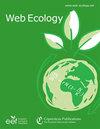鸟类颜色和分类多样性与城市公园中的人类干扰呈负相关
IF 2.4
3区 环境科学与生态学
Q2 ECOLOGY
引用次数: 0
摘要
摘要最近的研究表明,高度城市化地区的鸟类在数量上以灰色羽毛为主,这可能是由于它们喜欢用不透水的灰色表面进行伪装。然而,城市绿地中鸟类颜色多样性的模式仍未得到研究。在城市公园中,被高度城市化地区包围的地点可能以灰色鸟类为主,而有行人喂食鸟类的城市公园可能有利于同样具有灰色羽毛的共生鸟类。因此,我们探讨了城市公园中环境变量与鸟类分类和颜色多样性之间的关系。我们在阿根廷中部六个城市的城市公园中进行了两次定点鸟类调查。通过对鸟类身体不同部位的羽色特征以及是否存在羽色性二态性、多态性和彩虹色来评估鸟类的色彩多样性。然后,利用物种平均配对距离计算色彩丰富度和色彩多样性(基于丰度)。使用无效模型对丰富度校正后的色彩多样性进行量化。鸟类物种丰富度和多样性随绿地面积的增加而增加,鸟类多样性随行人流量的增加而减少。颜色丰富度随着车流量的增加而降低,而颜色多样性与绿地面积呈正相关,与车流量和人流量呈负相关。丰富度校正后的颜色多样性与汽车和行人流量呈负相关。在城市中心附近的公园中,灰鸟的数量有所增加,并与行人和汽车流量呈正相关。黄色鸟类的数量在农村地区或小城市附近的公园有所增加。颜色多样性随绿地面积的增加而增加,但丰富度校正后的颜色多样性不再与绿地面积相关。因此,颜色多样性随绿地面积增加而增加的原因是物种丰富度的增加。色彩多样性主要集中在人类干扰最严重的公园,这有利于灰色物种的丰富,它们可能利用了人类丢弃的食物。本文章由计算机程序翻译,如有差异,请以英文原文为准。
Bird color and taxonomic diversity are negatively related to human disturbance in urban parks
Abstract. Recently, studies have shown that highly urbanized areas are numerically dominated by birds with grey plumage, probably favoring camouflage with impervious grey surfaces. However, patterns of bird color diversity in urban green areas remain unexplored. In urban parks, sites surrounded by highly urbanized areas may be dominated by grey bird species, whereas urban parks with pedestrians that feed birds may favor commensal birds which also have grey plumage. Thus, we explore the relationship between environmental variables and bird taxonomic and color diversity in urban parks. Bird surveys were conducted twice by fixed points in urban parks of six cities in central Argentina. Bird color diversity was assessed by characterizing bird plumage coloration in different parts of the bird body and the presence of plumage sexual dimorphism, polymorphism, and iridescence. Then, color richness and color diversity (abundance-based) were calculated with species mean pairwise distance. Null models were used to quantify richness-corrected color diversity. Bird species richness and diversity increased with green-area size, and bird diversity decreased with increasing pedestrian traffic. Color richness decreased with increasing car traffic, whereas color diversity was positively related to green-area size and negatively related to car and pedestrian traffic. Richness-corrected color diversity related negatively to car and pedestrian traffic. The abundance of grey birds increased in parks near the urban centers and related positively to pedestrian and car traffic. The abundance of yellow birds increased in parks near rural areas or small cities. Color diversity increased with green-area size, but richness-corrected color diversity ceased to be related to area size. Therefore, the increase in color diversity with area size was mediated by increases in species richness. Color diversity was clustered in parks with the highest human disturbance, favoring the abundance of grey species which probably took advantage of food discarded by humans.
求助全文
通过发布文献求助,成功后即可免费获取论文全文。
去求助
来源期刊

Web Ecology
Agricultural and Biological Sciences-Ecology, Evolution, Behavior and Systematics
CiteScore
4.60
自引率
0.00%
发文量
6
审稿时长
17 weeks
期刊介绍:
Web Ecology (WE) is an open-access journal issued by the European Ecological Federation (EEF) representing the ecological societies within Europe and associated members. Its special value is to serve as a publication forum for national ecological societies that do not maintain their own society journal. Web Ecology publishes papers from all fields of ecology without any geographic restriction. It is a forum to communicate results of experimental, theoretical, and descriptive studies of general interest to an international audience. Original contributions, short communications, and reviews on ecological research on all kinds of organisms and ecosystems are welcome as well as papers that express emerging ideas and concepts with a sound scientific background.
 求助内容:
求助内容: 应助结果提醒方式:
应助结果提醒方式:


